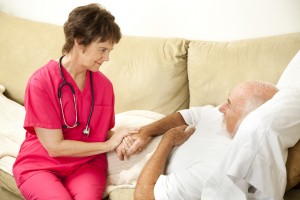Huge news for healthcare yesterday as the Supreme Court decided to uphold the Affordable Care Act.
The decision was uncertain enough that many hospitals suspended their preparations for the ACA; now the changes that began soon after the passage of the law in March 2010 can continue, with the core measures going into effect by 2014.
The president of the American Nurses Association, Karen A. Daley, is quoted by Nurse.com as saying, “This decision means millions of people will have access to the basic healthcare and preventive services that they’ve lacked.” The ANA has been a staunch supporter of the ACA.
She states that there will be savings throughout the system as people get the care they need to recognize problems earlier or avoid them completely.
The law has the potential to increase the profile of RNs in the healthcare system through models like accountable care organizations, which would rely on RNs’ expertise in care coordination. The law also has an impact on nurses through the $71.3 million in grants that it made available for programs that would strengthen the nursing workforce.
The long-term goal of such programs is to alleviate a possible nursing shortage in the wake of what is expected to be an influx of newly insured patients.
“[Nurses] are well-positioned to lead in providing essential prevention and wellness services and care coordination for individuals and families,” Daley said. “The law enhances opportunities for nurse practitioners and nurse midwives to provide primary care. This will increase accessibility for the growing number of people needing basic health services.”
With the law upheld, a long list of reforms to the healthcare system can continue. The mandate for people to buy insurance or pay a tax, which was central to the court challenge, will take effect in 2014. That same year, state-based exchanges for buying insurance will begin operating.
Along with tax credits and the expansion of Medicaid — which was affected by the Supreme Court ruling, but can still go through in some form — these provisions could extend coverage to more than half of the estimated 50 million people who lack insurance.
“Though people will continue to require emergency care, this decision means that millions of people will have access to basic, primary healthcare and preventive services, which should ultimately reduce the numbers of patients seeking routine care in the ED,” said Gail Lenehan, RN, MSN, EdD, FAEN, FAAN. “Patients will get the care they need earlier instead of becoming seriously ill and requiring complex, acute care in a hospital ED.”
Key provisions of the law center on insurance reform, prohibiting insurers from denying coverage to people with pre-existing conditions, imposing annual or lifetime coverage caps or discriminating on the basis of gender when setting premiums. These measures, along with a requirement for insurers to cover young adults through their parents’ policies until age 26, can stand with the mandate remaining in place.
Numerous other changes to the healthcare system include incentives to both patients and providers to increase preventive care; Medicare-payment incentives to providers to improve quality of care while lowering costs; and grants to build and expand community health centers, which are staffed by nurses and nurse practitioners.
Lola A. Coke, APRN-BC, PhD, CNS, FAHA, FPCNA, president of the Preventive Cardiovascular Nurses Association, lauded the ACA’s emphasis on preventive care. She said the ruling addresses “important disparities in the application of evidence-based strategies for management of high blood pressure, cholesterol disorder and diabetes.”
The PCNA plans to support RNs and APRNs in implementing team-based approaches to preventive cardiovascular care. The ruling “will go a long way in amplifying what we can do, and how many patients we can reach, in the clinical setting.”










